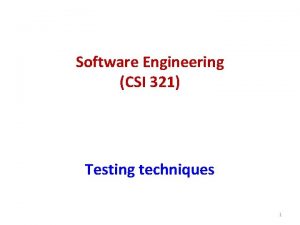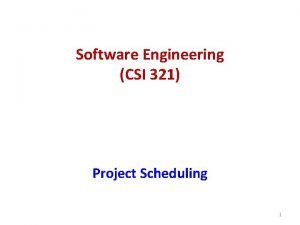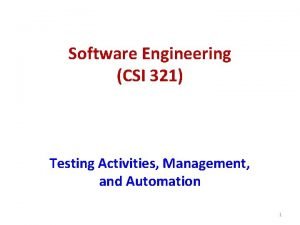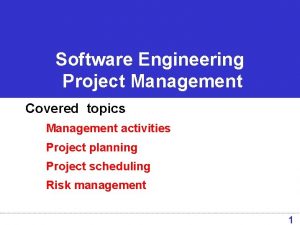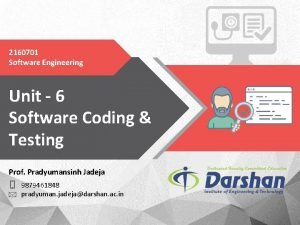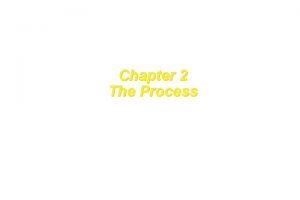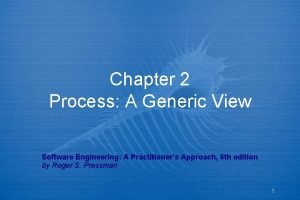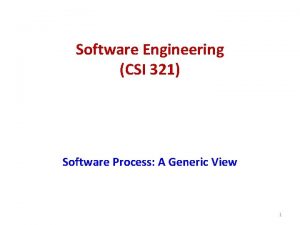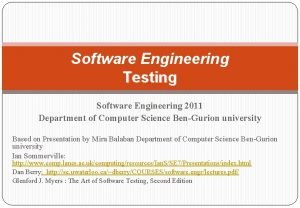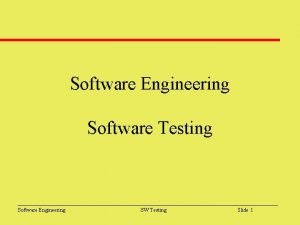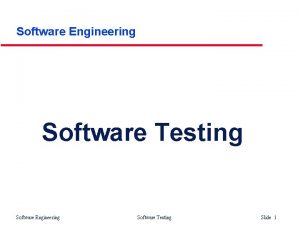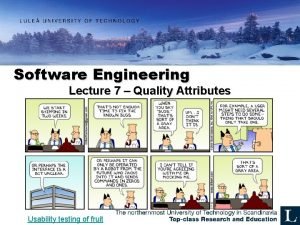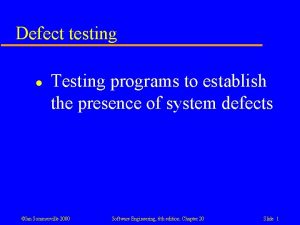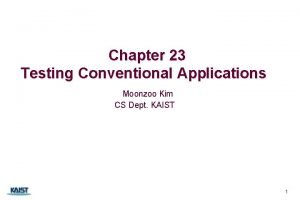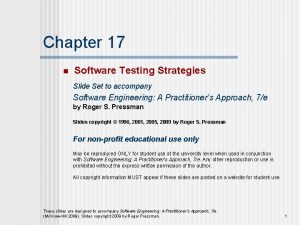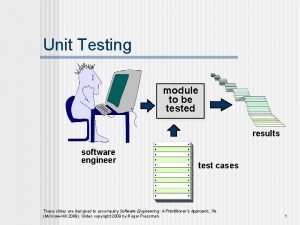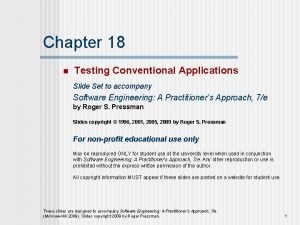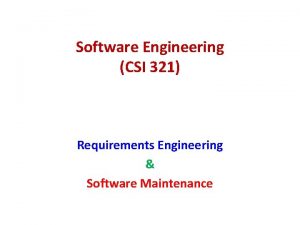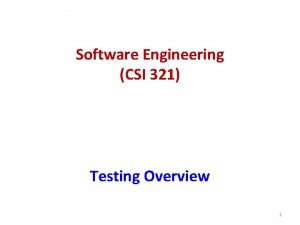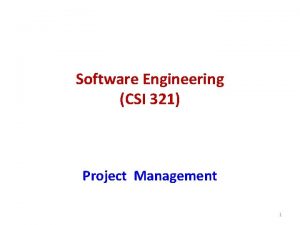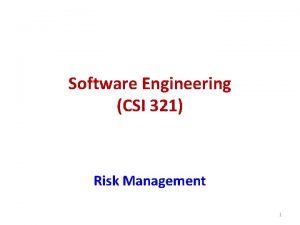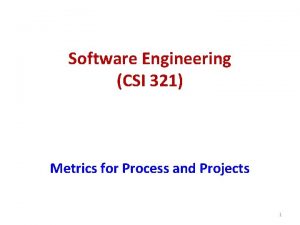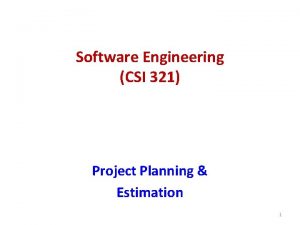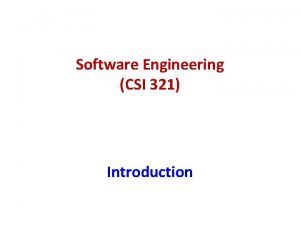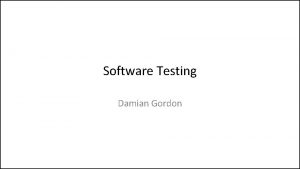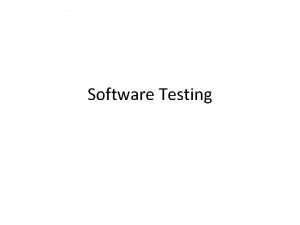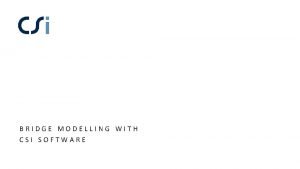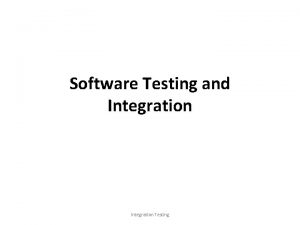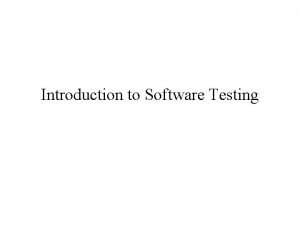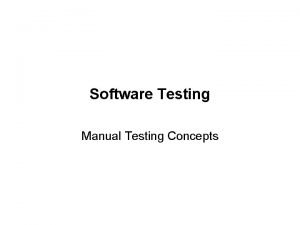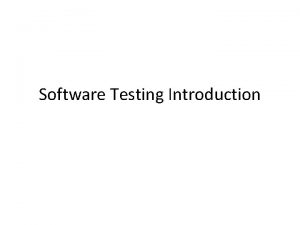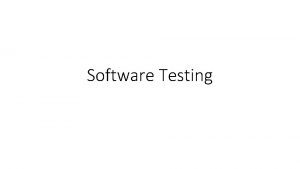Software Engineering CSI 321 Testing Activities Management and
































- Slides: 32

Software Engineering (CSI 321) Testing Activities, Management, and Automation 1

Outline § Major Testing Activities § Test Management § Test Automation 2

Major Testing Activities • Major Testing Activities: Generic Testing Process 1) Test planning and preparation – Goal setting – Information gathering – Test cases – Test procedures 2) Test Execution – Observation & measurements of product behavior 3) Analysis & Follow-up – Result checking and analysis ( to determine if a failure has been observed) – Follow-up activities 3

Test Planning and Preparation • Most important activity in the generic testing process for systematic testing. • Most of the key decisions about testing are made during this stage. • Test planning & test preparation are sometimes treated as separate groups of activities. – High-level test planning – Low-level activities related to test preparation 4

Test Planning and Preparation • Test Planning: The high-level task for test planning is to set goals & to determine a general testing strategy. – Goal setting – Overall strategy • Test Preparation: – Preparing test cases & test suite(s) – Preparing test procedure 5

Test Planning • Goal setting Quality perspectives of the customer Quality expectations of the customer Mapping to internal goals and concrete (quantified ) measurement e. g. customer’s correctness concerns ==> Specific reliability target • Overall strategy, including: Specific objects to be tested Techniques to use Measurement data to be collected Analysis and follow-up activities Key: plan the “whole thing” ! 6

Test Planning § We set an overall testing strategy by making the following decisions: • Overall objectives and goals, which can be refined into specific goals for specific testing. • Objects to be tested and the specific focus: Functional testing views the software product as a black-box and focuses on testing the external functional behavior; while structural testing views the software product or component as white-box and focuses on testing the internal implementation details. • Once the overall testing strategy has been selected, we can plan to allocate resources and staff to implement it. The available staff & resources also affect the specific models and techniques that can be used to implement the strategy. • Sometimes, existing test suites can be used with some minor modifications or adaptations, which would require minimal additional effort in test planning & preparation. 7

Test Preparation • Procedure for test preparation Preparing test cases – Individual test cases – Test case allocation Preparing test procedure – Basis for test procedure – Order, flow, follow-up 8

Test Preparation • General concepts Input variable: test point Input space: all possible input variable values Test case: A test case is a document that describes an input, action, or event, and its expected results, in order to determine if a feature of an application is working correctly. Test case: static object + input to enable test to start –execute –finish Test run: A test run is a dynamic unit of specific test activities in the overall testing sequence on a selected testing object. Test run ==> operational instances 9

Test Suite Preparation q Test suite (macro-level) • The collection of individual test cases that will be run in a test sequence until some stopping criteria are satisfied is called a test suite. • Test suite preparation involves the construction & allocation of individual test cases in some systematic way based on the specific testing techniques used. • Another way to obtain a test suite is through reuse of test cases for earlier versions of the same product. This kind of testing is commonly referred to as regression testing. • All the test cases should form an integrated suite, regardless of their origin, how they are derived, and what models are used to derive them. 10

Test Procedure Preparation § In addition to preparation of individual test cases and the overall test suite, the test procedure also needs to be prepared for effective testing. The basic question is the sequencing of the individual test cases and the switch-over from one test run to another. • KEY consideration: Sequencing of the individual test cases General: simple to complex Dependencies among individual test cases Defect detection related sequencing Sequences to avoid accidents Problem diagnosis related sequencing Natural grouping of test cases 11

Test Execution • The key to the overall test execution is the smooth transition from one test run to another, which also requires us to allocate all the required resources to ensure that individual test runs can be started, executed, and finished, and related problems can be handled seamlessly. • General steps in Test Execution: – Allocating test time (& resources) – Invoking and running tests, and collecting execution information & measurements – Checking testing results & identifying system failures 12

Test Execution • Allocating Test Time: • Test time & resources allocation is most closely related to the test planning & preparation activities. Although the allocation could be planned or even carried out at the previous stage, the monitoring, adjustment, and management of these resources need to be carried out during test execution. – Individual test cases ==> test time – Sum-up ==> overall allocation 13

Test Execution • Identifying system failures (oracle problem): Test oracle: Any means to check the testing result(Can decide whether or not a test case has passed) Analyze test output for deviations Determine: deviation = failure? Handling normal vs. failed runs 14

Test Execution • Failure observation and measurement: Determine: deviation = failure ? Establish when failure occurred Collect failure information: What /where/when/severity/etc. • Defect handling and test measurement: Defect status & change Information gathering during testing Follow-up activities: • Fix-verification cycle • Other possibilities (defer, invalid, etc. ) 15

Test Analysis and Follow-up • The third group of major testing activities is analysis and follow-up after test execution. The measurement data collected during test execution, together with other data about the testing & overall environment, form the data input to these analyses which provide valuable feedback to test execution and other testing & development activities. Direct follow -up includes defect fixing and making other management decisions, such as product release and transition from one development phase/sub-phase to another. Execution/other measurement analyzed Analysis results as basis for follow-up Feedback & Follow-up: – Decision making ( exit testing? etc. ) – Adjustment and improvement 16

Test Analysis and Follow-up • Input to analysis Test execution information Particularly failure cases Timing & characteristics data • Analysis and output: Basic individual (failure) case – Problem identification/reporting – Repeatable problem setup Overall reliability and other analysis? • Follow-up activities: Defect analysis & removal ( & re-test) Decision making & management Test process & quality improvement 17

Test Analysis and Follow-up q Analysis & Follow-up for test runs: Success: continue with normal testing Failure: see below § Analysis and follow-up for failed runs: • Understanding the problem by studying the execution record • Recreating the problem (confirmation) • Problem diagnosis ( to examine what kind of problem it is, where, when, and possible causes) ==> may involve multiple related runs • Locating the faults • Defect fixing (fault removal) Commonly via add/remove/modify code Sometimes involve design & requirement changes • Re-run/re-test to confirm defect fixing 18

Test Management § People’s roles/responsibilities in formal and informal testing • In informal testing: “run-and-observe” by testers “plug-and-play” by users Informal testing with ad hoc knowledge Deceptively “easy” , but not all failures or problems easy to recognize • In formal testing: Testers, and organized in teams Management/communication structure Role of “code owners” ( multiple roles? ) 3 rd party testing Career path for testers 19

Test Management • Test team organization: • The test activities need to be managed by people with a good understanding of the testing techniques and processes. • The feedback derived from analyses of measurement data needs to be used to help with various management decisions, such as product release, and to help quality improvement. Test managers are involved in these activities. • Testers and testing teams can be organized into various different structures, but basically following either a horizontal or a vertical model. However, in reality, a mixture of the two is often used in large software organizations. – Vertical model – Horizontal model – Mixed model 20

Test Management § Test team organization: i. Vertical model (project oriented) : A vertical model , would recognize around a product, where dedicated people perform one or more testing tasks for the product. Example: one or more teams can perform all the different types of testing for the product, from unit testing up to acceptance testing. ii. Horizontal(task oriented): A horizontal model is used in some large organizations so that a testing team only performs one kind of testing for many different products within the organization. Example: different products may share the same system testing team. iii. Mixed models might work better(in large software organizations) • External participants: Users & third-party testers: User involvement in beta-testing and other variations Independent verification & validation(IV &V) with third party testing/QA 21

Test Management q What are the different roles (of people) in major testing activities? • Testing activities for large-scale testing can generally be performed and managed with the involvement of many people who have different roles and responsibilities – 1) Dedicated professional testers and testing managers 2) Developers who are responsible for fixing problems, who may also play the dual role of testers 3) Customers and users, who may also serve as testers informally for usability or beta testing 4) Independent professional testing organizations as trusted intermediary between software vendors and customers 22

Test Automation • Software Testing: – Manual Testing vs. Automated Testing • Manual Testing: – Hard to repeat – Not always reliable – Costly Time consuming Labor intensive 23

Test Automation • Benefits of Automated Testing: – Fast – Reliable – Repeatable – Programmable – Comprehensive – Reusable 24

Test Automation • Basic understanding: • Test automation aims to automate some manual tasks with the use of some software tools. The demand for test automation is strong, because purely manual testing from start to finish can be tedious and error-prone. On the other hand, long standing theoretical results tell us that no fully automated testing is possible. • Although fully automated testing is not possible, some level of automation for individual activities is possible, an can be supported by various commercial tools or tools developed within large organizations. 25

Test Automation • The key in the use of test automation to relieve people of tedious & repetitive tasks and to improve overall testing productivity is to first examine what is possible, feasible, economical, and then set the right expectations & goals. Automation needed for large systems Fully automated: impossible Focus on specific needs/areas 26

Test Automation § Pre-requisites for test automation – The system is stable and its functionalities are well defined – The test cases to be automated are unambiguous – The test tools and infrastructure are in place – The test engineers have prior successful experience with automation – Adequate budget should have been allocated 27

Test Automation • Which Tests/Test cases to automate? – Tests that should be run for every build of the application ( smoke test, regression test) – Data tests that use multiple data values for the same inputs ( e. g. data-driven test) – Tests that require detailed information from the application internals (e. g. , GUI attributes) – Tests to be used for stress or load testing Repetitive execution, better candidate for automation 28

Test Automation • Which Test/Test cases should NOT be automated? • Usability testing – “How easy is the application to use? ” • One-time testing • “ASAP” testing –”we need to test NOW!” • Ad hoc/ random testing – Based on intuition, expertise, and knowledge of application • Tests without predictable results 29

Test Automation Question: Can test automation replace manual testing? • What do you think ? !!? 30

Test Automation Answer: No • Test automation can not replace manual testing. • Human creativity, variability, and observe-ability can NOT be mimicked through automation. • Automation can not detect some problems that can be easily observed by a human being. • Certain categories of tests ( e. g. , usability, interoperability) are often not suited for automation. • It is too difficult to automate all the test cases. • There will always be a need for some manual testing to some extent. 31

Summary • Test activities: Test planning and preparation Test execution & measurement Test result Analysis & Follow-up activities • Test management : Different roles and responsibilities Good management required • Test Automation: Set realistic expectations Specific areas for automation, especially in execution, measurement & analysis 32
 Csi 321
Csi 321 Pnr curve in software engineering
Pnr curve in software engineering Management myths in software engineering
Management myths in software engineering Testing activities in software engineering
Testing activities in software engineering Activities covered by software project management
Activities covered by software project management Testing types in software engineering
Testing types in software engineering What is domain testing
What is domain testing Kv charts in software testing
Kv charts in software testing Du path testing
Du path testing Localization globalization testing
Localization globalization testing Language testing
Language testing Control structure testing in software testing
Control structure testing in software testing Decision table testing in software testing
Decision table testing in software testing Decision table technique
Decision table technique Decision table for next date problem
Decision table for next date problem Rigorous testing in software testing
Rigorous testing in software testing Testing blindness in software testing
Testing blindness in software testing Software testing domains
Software testing domains Common process framework in software engineering
Common process framework in software engineering Generic view of process
Generic view of process Umbrella activities in software engineering
Umbrella activities in software engineering User testing software engineering
User testing software engineering Types of testing in software engineering
Types of testing in software engineering Sw in software engineering
Sw in software engineering Software engineering
Software engineering User testing software engineering
User testing software engineering Cluster testing in software engineering
Cluster testing in software engineering Testing conventional applications in software engineering
Testing conventional applications in software engineering What is regression testing in software engineering
What is regression testing in software engineering Module testing in software engineering
Module testing in software engineering Defect testing in software engineering
Defect testing in software engineering Testing conventional applications in software engineering
Testing conventional applications in software engineering Software measurement and metrics
Software measurement and metrics
